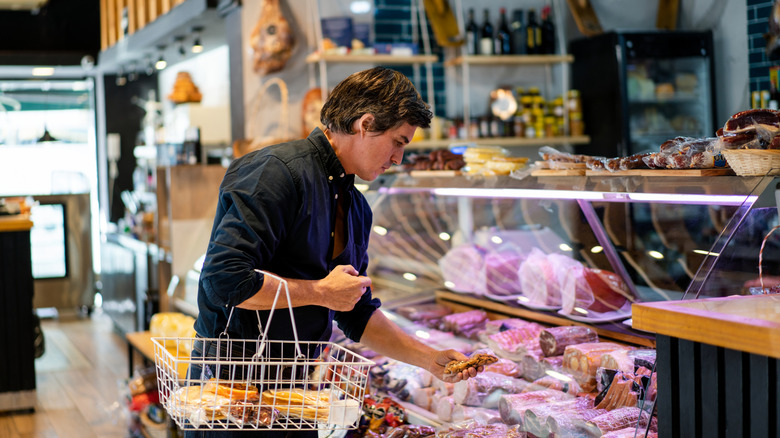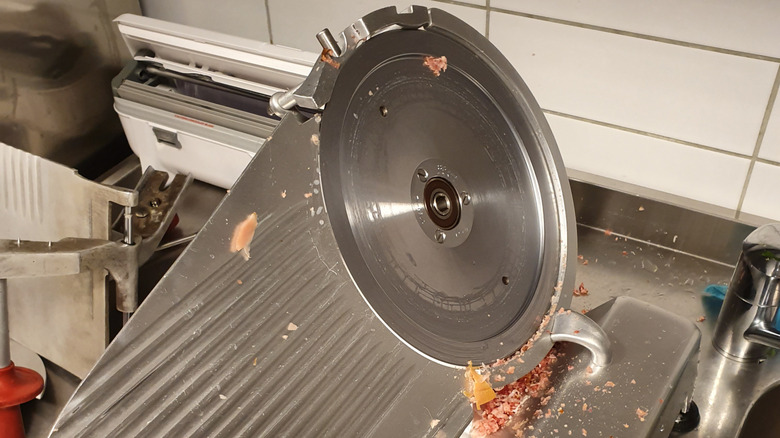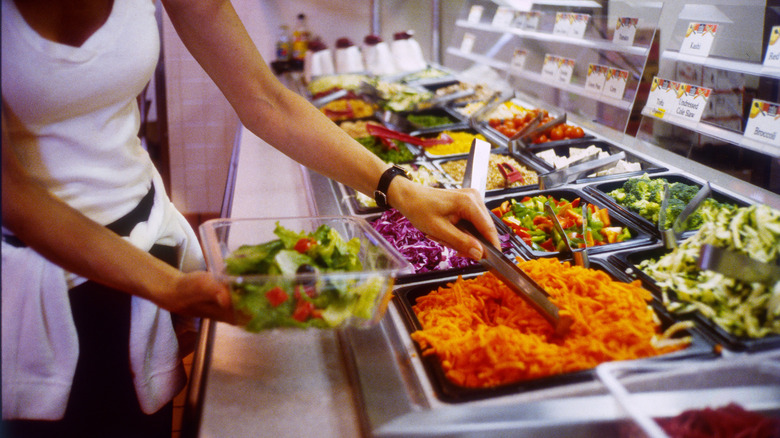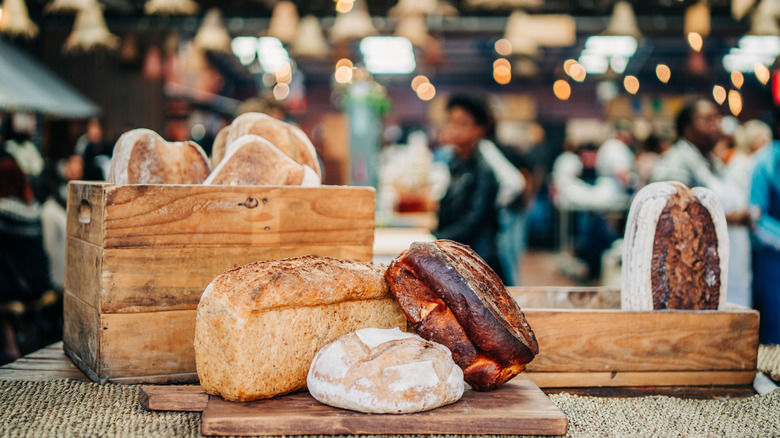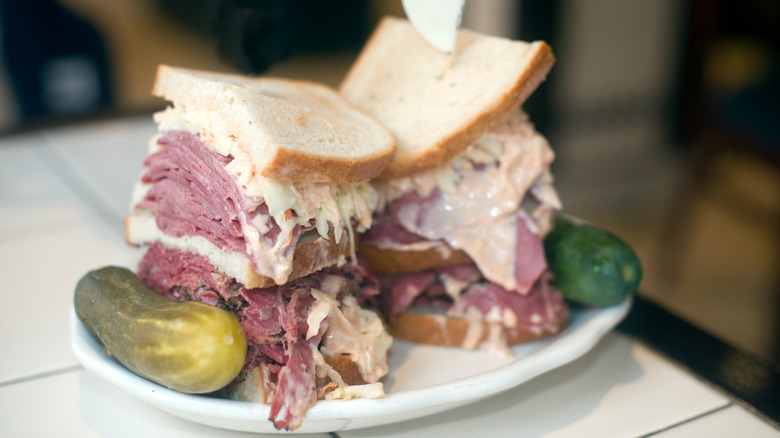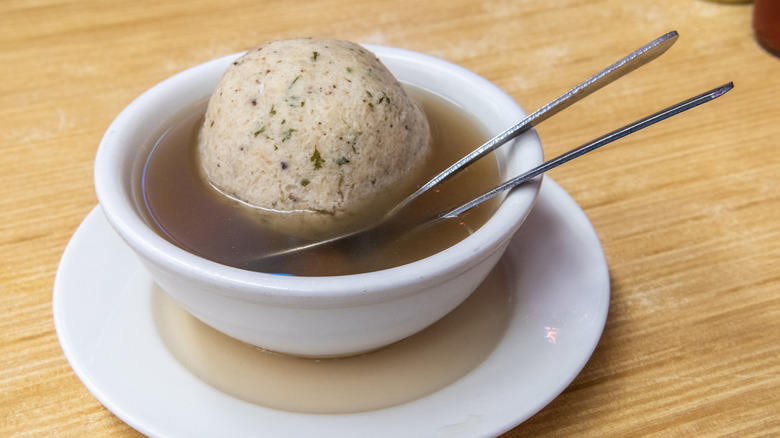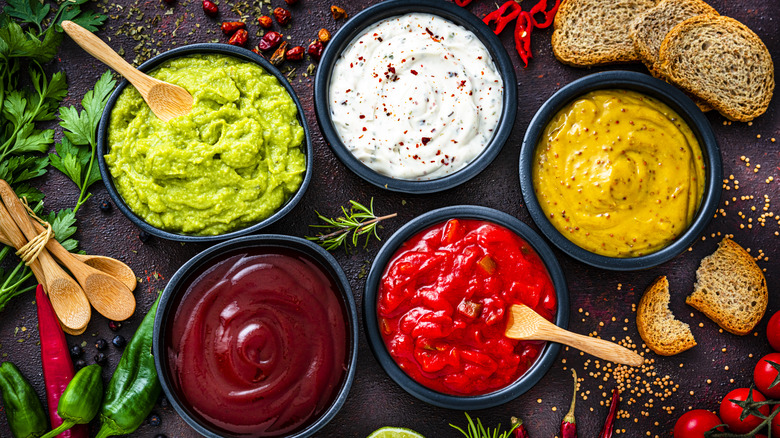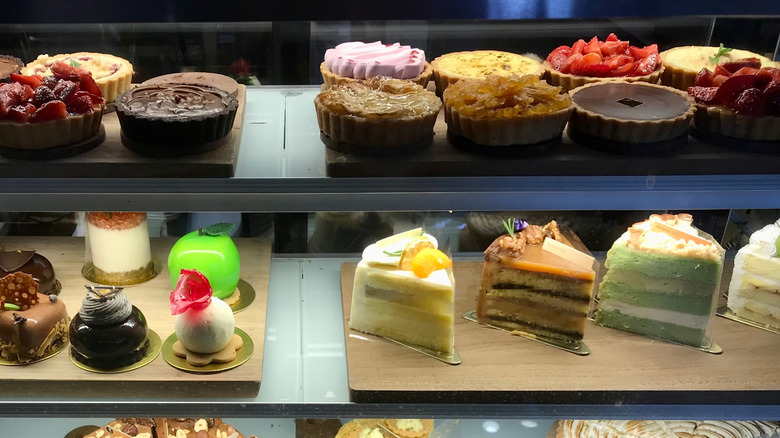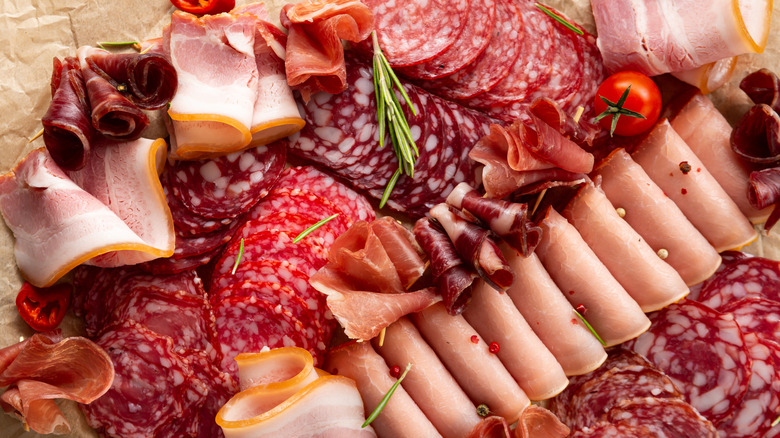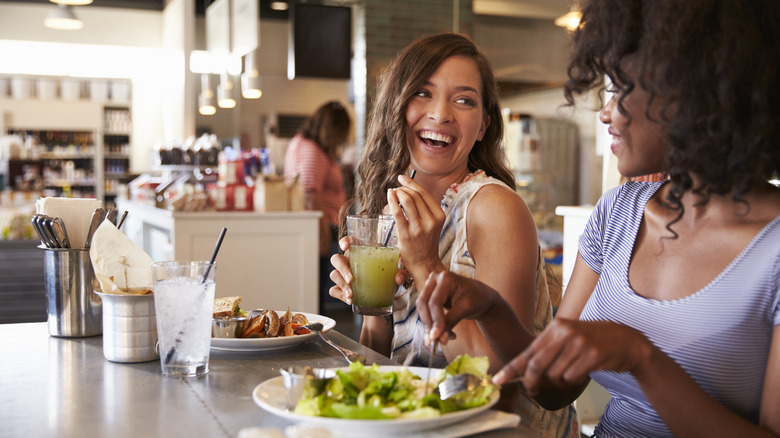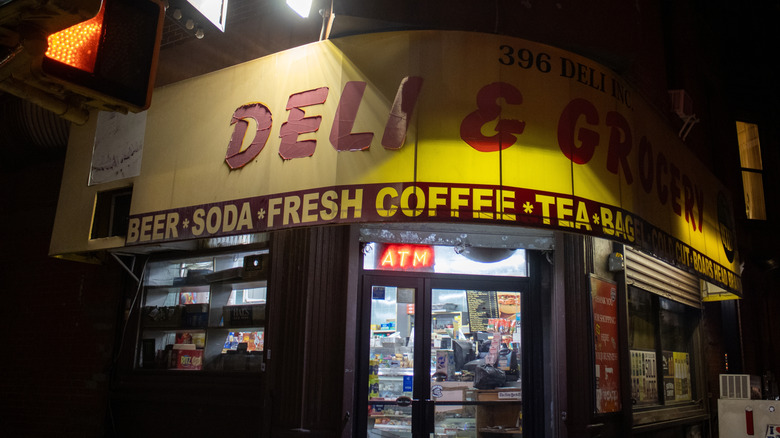Signs You Are In A Bad Deli
When it comes to casual dining options, it's hard to beat a good delicatessen. Jewish, Italian, or German — no matter the ethnicity, tasty sandwiches, salads, desserts, and deli specialties specific to the cuisine make for a delicious lunch or dinner. There are just things that always taste better in a deli. Delis are also fun places to sit down with family or friends and schmooze as you enjoy your meal.
The first delicatessen dates back to 1700 in Munich, Germany. During the 19th Century, immigrants, chiefly Ashkenazi Jews, brought the concept to New York. Over the decades that followed, delis spread to other cities, as well as suburban areas, and were joined by their Italian cousins. The delicatessen is a staple of American casual restaurants, to say nothing of the lasting cultural impact of the American Jewish deli.
However, like anything else, some delis are better than others. You want to patronize the good ones and avoid the not-so-good ones. How can you tell before you try the food? There are telltale signs — if you know what to look for, you can figure out which ones to avoid. We are going to provide you with some of the signs that a deli is not one you want to eat in.
The display counters or food slicers aren't clean
Cleanliness is next to godliness, and it is essential in any restaurant, including delicatessens. You can easily cross a deli off your list of potential dining spots if you see dirty glass display counters, and especially food slicers. Slicers come in contact with the meats and cheeses that go on your sandwich. If they haven't been properly cleaned, bacteria and germs can get on your sandwich fillings and into your body. Dirty deli slicers are one of the biggest sources of cross-contamination and can cause listeria in diners. The CDC estimates that each year, about 48 million people get sick from foodborne illnesses. Don't get yourself on that list.
Glass display counters contain the foods on sale. Dirt, dust, and other residues can contaminate food. If the tops of the counters are dirty, they can contaminate the hands of employees or customers by simply touching them. Beyond the health aspects, a deli display counter should be like one in a jewelry store — it shows off the precious wares. Pastrami may not sparkle, but you can't eat a half-carat Tiffany-cut stone.
The salads are subpar or premade
Salads are a staple of a good deli. These can be vegetable salads as well as pasta, macaroni, or potato salads. Tuna, egg, chicken, and ham salads are popular sandwich options. Salads that come into a deli premade or are not up to par are true signs of a bad deli. Premade macaroni, pasta, and potato salads, like the kind you find in supermarkets, often contain extra sugar, which can add calories and give the salad an unnatural sweetness. Also, premade salads may contain preservatives that are unhealthy.
The owners of a good deli take pride in all of their food and wouldn't dream of offering premade salads. Many have their own recipes and know, for example, the best way to punch up tuna salad. If you're not sure, ask if the salads are made in-house. It's important information. Keep an eye out for wilted vegetable salads that don't look fresh and excessive amounts of mayonnaise. Too much mayo adds fat and masks the flavor of the other ingredients.
The deli has few bread options
A sandwich is usually defined by its fillings. Meats, cheeses, and other toppings are important to the taste and texture. However, you can't neglect the bread. A sub shop will usually have just different types of sub rolls and sandwich places should have a couple of types of bread and maybe wraps. A good deli will have a fine selection of fresh-baked breads, some of which reflect the type of cuisine. What's a Jewish deli without rye bread, challah, and of course, bagels? Or an Italian deli without ciabatta and Italian bread? For German delis, the absence of pumpernickel is a red flag.
Kaiser rolls, pitas, and French bread are other options you like to see in a delicatessen. Multi-grain breads, whole wheat, and marble rye add to the choices you have to order the perfect sandwich. The more options, the better, especially when they come in fresh-baked daily. The outer layer of the sandwich contributes to the blend of flavors and textures that make it so scrumptious. If you walk into a deli that has just white bread and hard rolls, walk back out. It's one of the bad ones.
The sandwiches have small amounts of fillings
Something good delis are really known for is hearty sandwiches. Walk into a legendary deli like Katz's in New York and order a corned beef or pastrami on rye. Your sandwich will be piled high with delicious, freshly-sliced meat. The same goes for a good deli's Italian combo, Reuben, chicken salad, or any other deli sandwich you can think of. You'll also get plenty of cheese, vegetables, condiments, and any other toppings you order. The best sandwiches are like monumental works of art and demonstrate that the owners are proud of their food and are dedicated to satisfying the biggest of appetites.
No one should ever leave a deli hungry. In fact, you will frequently end up with leftovers for tomorrow's lunch. You get good value for your money in the best delicatessens. Stay away from delis that serve skimpy sandwiches with just two or three slices of meat. Find a good one, and enjoy a feast.
The deli doesn't make soups from scratch
One of the great complements to a good sandwich is a delicious cup or bowl of soup. Soup and a sandwich, that's a meal! The best delis have soup on the menu, and a competent deli cook knows why your soup is bland and knows how to make sure theirs is packed with flavor. Any good Jewish deli will have pots steaming with matzo ball, beef barley, borscht, and of course, the greatest medicine of them all, chicken noodle all made from scratch. Italian delis don't slouch in the soup department either, and the good ones will have wedding bell, tortellini, minestrone, Tuscan vegetable, and of course, pasta e fagioli.
A tasty soup is warming on cold days, and even during the summer, it can be quite soothing. When you are checking out a new deli, keep an eye out for soup and find out if it's homemade. If not, that's an establishment to cross off your list.
The deli's condiments selection is insufficient or second-rate
A truly delicious sandwich is made up of multiple components. In addition to meats, cheeses, and breads, we must consider condiments. These ingredients are not to be overlooked, as they add flavor and texture to a sandwich and are often the finishing touch. A deli that just has yellow mustard, mayo, and ketchup is not one you want to patronize. A great deli has a wide variety of condiments that are not the low-priced brands you find in supermarkets.
You want to see high-quality mustards with varied flavors. Yellow, brown, spicy, sweet, stone ground, horseradish, garlic — you get the idea. Regarding mayonnaise, the best delis make their own. Physician and nutritionist Dr. Steven Masley says, "I have avoided store-bought mayo because it is packed with chemical and gut irritants and it does not taste nearly as delicious as homemade mayonnaise." Delis will usually have more than one kind of mayo, sometimes a secret variety of mayonnaise you've probably never heard of called heavy-duty mayo, which contains extra egg yolks and lemon juice, making it creamier. It is well-suited to use in tuna, chicken, and egg salad.
There are also other types of condiments and sauces that can elevate a sandwich. Pesto, Russian dressing, oil, aoli, and vinegar are common options in good delis. Don't settle for basic add-ons. The better ones make a difference.
The deli has a lack of desserts
People go to delis for an indulgent dining experience. In addition to sandwiches, salads, and beverages, the best delis offer a variety of delicious desserts. The selection depends on the type of deli. You'll find cheesecake, rugelach, and babka in a Jewish deli. An Italian establishment will serve canolis, tiramisu, and Italian cookies, as well as crostata, the traditional Italian dessert that came well before tiramisu. No New York deli worth its salt will be without black and white cookies. Black forest cake and Bavarian-style pastries fill the cases of a good German deli.
You may also see other kinds of cakes, cookies, and pastries at a high-end deli. These should be fresh-baked and not off of supermarket shelves. A deli with a small selection of desserts, especially if they are store-bought or subpar, is not one you want to dine at. It's another of those details that show that a deli is the real deal.
The deli doesn't have specialty foods
There are, of course, delis of different ethnicities. This is one of their more attractive features. You choose the kind of cuisine you are currently craving. A good deli will have a variety of foods from the culture it represents. For example, a Jewish deli should have kasha and potato knishes, latkes, big dill pickles, and kosher meats like pastrami, salami, and corned beef. Let's not forget whitefish and herring.
Step into an Italian deli and you should see fresh salami, ham, capicola, mortadella, and other Italian meats hanging behind the counter. You will also expect pasta salads, antipasto, and other Italian specialties. A good German deli will be offering liverwurst, knackwurst, headcheese, German bologna, German potato salad, and of course, sauerkraut. This shows authenticity and that the owners know what they are doing. A bad deli doesn't reflect its heritage, which is a sign of a lack of knowledge and/or caring. Either is a true sign of a bad deli. Avoid these kinds of places.
The cold cuts look slimy
Deli meat that is shiny and slimy has gone bad and can cause serious illness if consumed. Cold cuts that have gone bad will taste terrible and have an awful mouth feel, and even worse, they can also cause serious illnesses. Look closely at the deli meats on display and after slicing. If they look slimy or dried out and brown around the edges, they are past their freshness, and you should not consume them. Slimy-looking meat may be infected with harmful bacteria that will make you sick.
Delis that serve cold cuts that look slimy are absolutely to be avoided. If the meat looks that bad, it shows a lack of food knowledge and concern for food safety. Other foods may have also been neglected as has the hygiene of the employees, equipment, and the deli itself. No restaurant of any kind that has spoiled food should be patronized for any reason whatsoever. In fact, such establishments should not even be open. Under no circumstances should you ever eat in one of these delis. These are bad with a capital "B."
The deli has pre-sliced meat
Some delis will take shortcuts to help them get through busy times. This may seem like a good idea but one thing that they sometimes do is to pre-slice the meat. It may be wrapped up for use in sandwiches or sold in packages. It's a time-saver, and you may wonder what the harm is. The problem is that when meats are sliced, they become more exposed to the air, increasing the opportunity for bacterial growth and make them go bad faster.
Bacteria can lead to listeriosis in anyone who eats a sandwich made with the infected meat. Pregnant women and people over 65 are especially vulnerable. There is no guarantee that pre-sliced meat is infected, but a good deli knows better than to take that chance. Owners who aren't aware of this or just go ahead and take the shortcut anyway may have other problems in their establishments as well. This is a sign of a bad deli. Step outside and choose a better delicatessen.
The deli doesn't have a welcoming dining area
Most delis do takeout, and that is certainly convenient. However, sometimes, you just want to sit, eat, and hang out with the gang. In fact, delis have long been centers of the communities they serve, especially in major cities like New York and LA. To truly enjoy this aspect of a delicatessen, it must have a welcoming area with tables and chairs where patrons can sit in groups and schmooze while they eat.
A bad deli has no dining area, or one that's small, cramped, dark, dingy, or dirty. None of these things make for a welcoming space and will detract from your social and dining experience. On your recon mission to a new deli, take a look at the seating offered. If it doesn't look like a place you'd want to hang out in for a while, pass on the deli. A good meal is about more than just nourishment. It should be an enjoyable life experience.
Sandwich toppings appear less than fresh
Another vital component to a really tasty sandwich is toppings, such as various vegetables. Most sandwich shops have, at the minimum, lettuce, tomato, onions, and pickles. Delis will add to that several kinds of peppers, both sweet and hot, cucumbers, cole slaw, Russian and other kinds of dressing, and for the famous Reuben, sauerkraut. For these toppings to taste good and elevate the sandwich, the quality of them is important.
When you are scouting out a deli, take a close look at the sandwich toppings. In a good deli, the lettuce is fresh, green, and crisp. Other veggies and cole slaw and sauerkraut should look freshly made. Beware of brown, shriveled, and slimy-looking toppings. Look out for brown or black spots on tomatoes and peppers. A deli that is using old toppings is no place to have a meal. It is poorly run and shows a complete lack of concern for the safety of customers. Step out and find a better delicatessen.
The deli serves bad coffee
People love coffee. According to the National Coffee Association, 62% of Americans drink coffee every day, and 70% at least once a week. It's a beverage that can be soothing and delicious, and it can perk you up, too. Think about how many people love to have a chat or meeting over coffee. A common first date idea is, "let's have coffee." A good deli will have pots brewing with regular and decaf coffee all day long.
A sign of a bad deli is one that has lesser-brand "gas station coffee," or worse, instant, or worst of all, no coffee. Look for coffee makers behind the counter, and don't be afraid to ask what brand the deli serves. Even if you don't drink coffee, a deli with bad coffee probably doesn't pay attention to other important details, and you should consider crossing it off your list.
Along with the coffee, check that the deli offers add-on options such as real sugar, artificial sweeteners, whole milk, skim, oat milk, and other coffee add-ons that accommodate a wide variety of customers. This shows that they care about their clientele and that is always a good sign in any business.
